Error processing SSI file
|
Mission Blog: Sept. 25, 2009
Chelsea Lowes, Onboard Cruise Log Coordinator
Knauss Sea Grant Fellow, NOAA Ecosystem Research Program
Today we finished revisiting all 30 of our permanent sites! Sites today were along the northern border of the Tortugas Ecological Reserve. Lower visibility due to stirred up sediments makes it very important for divers to stay near each other while doing their transects so they do not lose sight of one another.
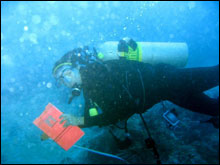 |
| Kim Edwards is easier to spot with a hot pink clipboard. (Photo: NOAA CCFHR) |
Many of the sites today were also very deep - some over 100 feet! When diving to those depths, divers carry a special piece of equipment known as a Reserve Air Supply System or RASS. This extra air tank provides a secondary source of air in the unlikely case a diver were to run out of air on the bottom or on their way to the surface. It is an extra precaution that keeps our divers safe, which is the number one priority of this cruise - the science comes second. Another piece of safety equipment is the diver recall system that each small boat carries.
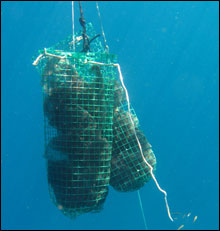 |
| Fish settlement traps attract juvenile fish seeking shelter. Large mesh bags (3/4 inch squares) filled with smaller window-screen mesh. (Photo: NOAA CCFHR) |
This alarm system can alert divers to a problem or emergency at the surface. When the coxswain sounds a bell underwater it means that the divers should stop their work, gather their gear, and return to the surface. If a siren is sounded, it means that divers should immediately make a safe ascent to the surface without retrieving their gear. In the past divers have been recalled due to stormy weather conditions, and sometimes due to waterspout sightings! Thankfully, no diver recalls have been needed during this cruise.
This afternoon John Burke and Brett Harrison deployed two fish settlement traps designed to attract fish that are just changing from their larval stage to their juvenile stage and are looking for shelter.
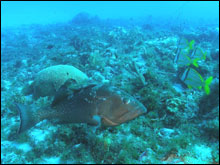 |
| Red grouper have been attracted to the activities of our divers. (Photo: NOAA CCFHR) |
Larval fish are carried along with the currents in the ocean and can end up very far from adult spawning sites. Later in a laboratory setting, the chemical characteristics of specific bones can reveal where a fish hatched and grew. Isn't science cool?! We will go back in a few days to check the traps - maybe we'll catch some fish that hatched near Mexico!
Divers continue to report sightings of big groupers. Red grouper are frequently mentioned - they seem to enjoy following divers around as they conduct their transects!
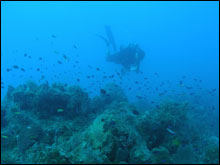 |
| Wrasses and damselfishes are pictured with Brian Degan over the reef. (Photo: NOAA CCFHR) |
Fish counters have to understand the behavior of reef fish species - they do not want to 'double count' a curious grouper. These divers have to be able to identify thousands of possible reef inhabitants on sight - and not only do they have to identify the more obvious adults, but they also have to be able to identify juvenile fish that can have a dramatically different shape, size, and coloration when compared to an adult of the same species. Aside from identification, these divers have to count the number of each kind of fish that they see. This can be very easy if they are encountering only one or two fish at a time; however, often divers encounter entire schools of fish or multiple species of fish all swimming together. Add in movement and you get an idea of what our fish counters are up against!
. . . . . . . . . . . . .
Northern Margin of the Tortugas Banks
John Burke, Chief Scientist
NOAA Center for Coastal Fisheries and Habitat Research
Today we finished the last of the thirty permanent stations visited each year to monitor trends in the reef community. We've seen many beautiful sights; spectacular corals, giant sponges, fields of the little clover like seagrass Halophila carpeting the shelf...
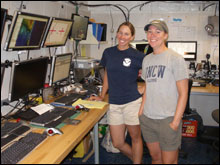 |
| NOAA Ship Nancy Foster survey technicians, Samantha Allen (left) and Melody Ovard (right). (Photo: NOAA CCFHR) |
The fish community appears much richer than when we first started our surveys in 2000. Mutton snapper, rarely seen during the early years of the survey, are now seen on almost every dive. The mighty goliath grouper, a species listed as a species of special concern due to overharvest has been sighted half a dozen times this trip.
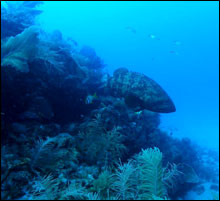 |
| Goliath grouper. (Photo: NOAA CCFHR) |
Tomorrow we shift gears and concentrate our surveys geographically to the area where the Tortugas Ecological Reserve boundary bisects the western Tortugas Bank. During the last three nights, Melody Ovard and Samantha Allen, the survey techs, have focused the ship's multi-beam sonar system on the western bank (Tortugas Bank) to provide us with a picture of its contours. We plan to use this detailed information to develop a sampling plan that will provide a regional comparison of the reef community in and outside the reserve. An exciting weekend planned!
|



